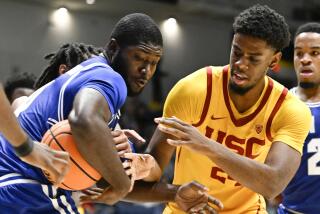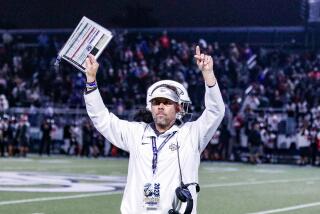Seton Hall Finally Reaping Benefits of Big East Conference
- Share via
“The best thing about Seton Hall is that it’s in the Big East Conference,” P.J. Carlesimo once noted from the perspective of head basketball coach. “The worst thing about Seton Hall is that it’s in the Big East Conference.” Clearly, membership has been a two-sided backboard for the South Orange, N.J., institution.
Because Seton Hall wasn’t fully committed to competing against the powerhouse teams in such an elite group, it languished at the bottom for most of the decade. But precisely because it belonged to such a high-profile league, it had the ability to attract talent capable of playing with the best teams in the nation. The source of its failure would be the source of its success.
Now that the Pirates sit atop the Big East Conference, Carlesimo can testify -- without apparent embarrassment -- that if the program hadn’t been in such dire straits, it might not have taken a chance on a small-name coach from Wagner College in 1982. “People didn’t want the job,” he said Wednesday evening. “It didn’t pay enough for them to get a proven, successful, big-time guy.”
Carlesimo has become all of the above in the last two seasons. A year ago, the Pirates reached the semifinal round of the Big East postseason tournament for the first time, qualified for their initial NCAA Tournament berth and won a game before bowing to top-seeded Arizona. Already this season they have won 13 games, climbed into the Top 10 in the wire-service polls and knocked off perennial power Georgetown before the largest crowd ever to witness a college basketball game in New Jersey.
The 19,761 fans at Meadowlands Arena in East Rutherford Tuesday night represented a triumph for Carlesimo as well as a breakthrough for the Big East. Speaking from Syracuse, where he was scouting the Pirates’ next opponent against Pittsburgh, the coach was ecstatic about the turnout. “In the long run,” he said, “I think it’s more significant than the result of the game.”
Although the 94-86 victory enabled Seton Hall to remain tied with another upstart, Providence, for first place in the conference, it was only one step in a long, competitive season. But the size of the crowd offered irrefutable proof that after decades of virtual anonymity, the program had arrived as a presence in Eastern basketball.
“It wasn’t as if there was nothing else going on,” Carlesimo said, “and we got all the basketball junkies. The Knicks were playing the Celtics at the Garden before 19,500. The timing was right. We caught Georgetown undefeated and we had that great start. But it was still mind-boggling.”
Seton Hall was not a prime candidate when the conference was formed in 1979. Organizers wanted Rutgers, but when New Jersey’s state university hesitated, the Pirates were invited to join. The Hall’s rich basketball tradition, like the trophies and old pictures in Walsh Auditorium, had been gathering dust. “We were good in the ‘60s,” Carlesimo noted last year. “We were great in the ‘50s. Kids don’t know that.”
When Carlesimo arrived on the campus in the fourth year of Big East play, there was no basketball secretary, no full-time assistants. “I remember how proud we were just to get four permanent side baskets in the gymnasium,” he said. At first, the school didn’t have the resources to compete. The construction of Meadowlands Arena presented Seton Hall with a chance to follow the conference’s growing demands and to show a profit.
“It has saved our program in a lot of ways,” the coach said. As the Pirates registered moderate gains in attendance, Carlesimo recalled, “We would brag about drawing more than five or six teams. I’d play that game all the time. St. John’s would fill Alumni Hall with 6,000 and the same would be true in Pittsburgh. Even Providence didn’t have that many seats. We’d brag about 12,000, but all the while there would be 7,000 or 8,000 empty seats.”
Until Tuesday. That night, the Pirates were as big a draw as the Knicks and Celtics just a few miles away. As was the case with the conference, Seton Hall’s location in the New York metropolitan area was both an asset and a disadvantage. The disadvantage was the fierce competition for media attention and fan interest in a region populated by so many professional teams and dominated, in the sphere of college basketball, by St. John’s. The extent of the asset was obvious against Georgetown. Thousands of people and tremendous exposure.
Carlesimo knows all about the territory. He was a player and an assistant coach at Fordham in the Bronx before building the program at Wagner on Staten Island. While at Wagner, he came within a last-second jump shot of beating St. John’s in the ECAC postseason playoffs. A Carlesimo team finally succeeded in besting the Redmen last month, and at Alumni Hall.
More to Read
Go beyond the scoreboard
Get the latest on L.A.'s teams in the daily Sports Report newsletter.
You may occasionally receive promotional content from the Los Angeles Times.










